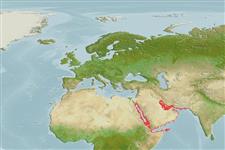Environment: milieu / climate zone / depth range / distribution range
Ecologie
marien rifbewoner; standvastig; diepte 4 - 55 m (Ref. 5222), usually 15 - 20 m (Ref. 89707). Tropical; 33°N - 10°N, 32°E - 66°E (Ref. 5222)
Western Indian Ocean: only from the northern end of the Red Sea to the Persian Gulf and coast of Pakistan. Records from elsewhere are apparently based on misidentifications of other species. Misidentified as Cephalopholis miniatus by Kuronuma & Abe (1986, Ref. 5999) from Kuwait.
Grootte / Gewicht / Leeftijd
Maturity: Lm ? range ? - ? cm
Max length : 35.0 cm TL mannelijk / geslacht onbekend; (Ref. 5222); common length : 23.0 cm TL mannelijk / geslacht onbekend; (Ref. 5450); max. gerapporteerde leeftijd: 26 Jaren (Ref. 1784)
Dorsale stekels (totaal): 9; Dorsale zachte stralen (totaal): 8-10; Anale stekels 3; Anale zachte stralen: 8 - 10. distinguished by the following characteristics: body depth 2.7-3.0 in SL; head length 2.4-2.6 in SL; flat interorbital area; rounded preopercle, finely serrate, lower edge fleshy; distinctly convex upper edge of operculum; scaly maxilla, reaching to or somewhat beyond vertical at rear edge of eye; ctenoid body scales, without auxiliary scales (Ref. 089707).
In the Red Sea, it is often found on patchy open reef areas. Feeds diurnally on fishes (64%, mostly pomacentrids) and crustaceans (36%). It is a monogamous species, the pair jointly defends a common territory of up to 62 square m (Ref. 6480). Major threats include overfishing, lack of management and habitat loss (Ref. 089707).
Levenscyclus en paargedrag
Maturiteit | Voortplanting | Paaien | Eieren | Fecunditeit | Larven
Displays obligate monogamy where a one-to-one pair is established irrespective of resource abundance (Ref. 52884).
Heemstra, P.C. and J.E. Randall, 1993. FAO Species Catalogue. Vol. 16. Groupers of the world (family Serranidae, subfamily Epinephelinae). An annotated and illustrated catalogue of the grouper, rockcod, hind, coral grouper and lyretail species known to date. Rome: FAO. FAO Fish. Synop. 125(16):382 p. (Ref. 5222)
Status op de Rode Lijst van het IUCN (Ref. 130435)
Gevaar voor de mens
Harmless
Gebruik door de mens
Visserij: visserij voor eigen gebruik
Meer informatie
ReferentiesAquacultuurAquacultuurprofielKweeklijnenGeneticaElectrophoresesErfelijkheidZiektesVerwerkingNutrientsMassaconversie
Tools
Speciale rapporten
Download XML
Internetbronnen
Estimates based on models
Preferred temperature (Ref.
123201): 25.1 - 29.3, mean 27.3 °C (based on 46 cells).
Fylogenetische diversiteitsindex (Ref.
82804): PD
50 = 0.5000 [Uniqueness, from 0.5 = low to 2.0 = high].
Bayesian length-weight: a=0.01259 (0.00590 - 0.02687), b=3.04 (2.87 - 3.21), in cm total length, based on LWR estimates for this Genus-body shape (Ref.
93245).
Trofisch niveau (Ref.
69278): 4.1 ±0.6 se; based on diet studies.
Generation time: 10.0 ( na - na) years. Estimated as median ln(3)/K based on 1
growth studies.
Weerstandsvermogen (Ref.
120179): laag, minimale populatieverdubbelingstijd 4,5-14 jaar (K=0.11).
Fishing Vulnerability (Ref.
59153): High vulnerability (58 of 100).
Climate Vulnerability (Ref.
125649): Very high vulnerability (88 of 100).
Nutrients (Ref.
124155): Calcium = 43.4 [24.0, 76.6] mg/100g; Iron = 0.5 [0.3, 1.0] mg/100g; Protein = 18.2 [16.4, 19.9] %; Omega3 = 0.154 [0.096, 0.249] g/100g; Selenium = 32.4 [17.4, 57.8] μg/100g; VitaminA = 237 [72, 838] μg/100g; Zinc = 0.929 [0.638, 1.466] mg/100g (wet weight);
